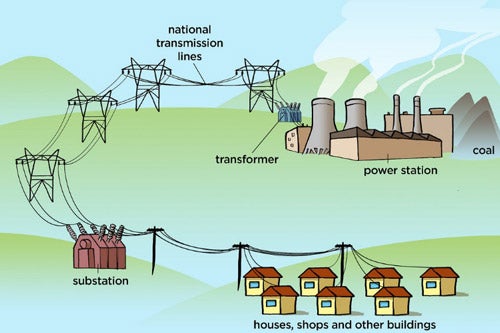Outage FAQs
How does electricity get to my home?
Before electricity can reach your home, it must be generated by a source. This source can be a conventional natural gas generator plant, nuclear plant, coal plant, or even from renewable energy such as solar or wind. Due to the large amounts of electricity that must flow out from the generator (power station), transmission lines or large conductors are needed to support the high voltage. Transmission lines then transport the electricity to a substation where the distribution lines carry medium voltage to distribution transformers. The distribution transformer then supplies electricity to the individual consumer.

What is voltage fluctuation and why does it happen?
Voltage fluctuations are experienced when the normal voltage supply to the consumer dips or spikes. These fluctuations can be caused by large power draws on the distribution line. CVEC uses special equipment in the substations and on the distribution lines to help counter voltage fluctuations.
Why does my power flicker or blink?
A flicker or blink in the power service to the consumer is typically caused by a temporary fault on the distribution line. CVEC has installed special equipment on the distribution lines that will cause the line to blink to avoid a long-term outage. This works best when a tree blows in the line temporarily or lightning strikes a pole or a snake contacts energized lines. The special equipment will sense the fault, temporarily de-energize the line so that the fault condition can clear, and then re-energize the line to see if the fault has cleared. This is where the consumer will see a flicker or blink. The special equipment uses a multitude of settings to coordinate with all distribution equipment on the line. Therefore, depending on the settings in the special equipment and the consumer's location on the distribution line, the consumer may see different durations and quantities of blinks. Once the settings threshold has been met, the next step is for the special equipment to de-energize the line until crews can come onsite to investigate.
What is an outage and what causes them?
An outage occurs when the consumer loses all flow of electricity from the grid. This can be in the form of an instant outage or after a series of blinks from the special equipment installed on the line used to thwart an outage. However, sometimes an outage is inevitable. Outages can be caused by equipment failures, downed equipment, protection devices, and transmission issues. For example, some of our protection devices are designed to de-energize sections of line so that additional damage does not occur on the lines, which would take longer to repair and could be costlier to the cooperative.
What does it mean if I have an outage but CVEC says that it is on the transmission side?
CVEC can only control the electricity once it gets to the substation, prior to that, it is on the transmission provider. If an outage occurs upstream of the substation, CVEC is at the mercy of the transmission provider just as any other distribution provider would be. For example, if CVEC loses power to a couple of substations, it is likely that other distribution providers interconnected to that same transmission line have lost power as well. Below is an illustration of this. If an issue arises between Transmission A and the Substations, then all consumers downline of this issue will lose power. The distribution power providers for each substation have no control of the upline issue.

Where can I go to verify that CVEC is aware of my outage?
You can visit the CVEC Outage Map or call us at 325-655-6957.
Why does my neighbor have electricity but I don't?
It is possible for you neighbor to have electricity but you to not. This can be explained if you are on a different distribution line compared to your neighbor or if a transformer has an outage, you both may not be on the same transformer. This is another good reason for a Member to call in and report the individual outage.
Why does my electricity come back on for a while after an outage but then go off again?
This type of situation can be explained by several reasons.
- Our crews may have done what was necessary to get your electricity back on in a safe and efficient manner but the solution may have not been permanent. The crews may need to de-energize the lines to safely make the permanent fixes.
- Or CVEC may have temporarily moved the distribution line you are on to another substation source. Since this is not the normal arrangement, the distribution line will eventually get placed back on the original substation source, which would result in an additional outage. This identical situation can also happen on the transmission side.
Why can't I get electricity provided to me without interruption?
The cost to provide electricity without interruption and to provide back-up power for every Member would be unrealistic.
Will renewable energy help?
Renewable energy, such as solar, can be installed on Member's homes. However, this technology does not work without an AC (Alternating Current) source. This is an industry wide standard put in place to protect utility workers. Please visit our DG FAQ page.
What is CVEC doing to mitigate outages?
CVEC is constantly looking at coordination of our special equipment on our constantly changing distribution system to better handle outages. CVEC continues to research new and emerging technologies assist CVEC in providing safe and reliable electricity to our Members.




